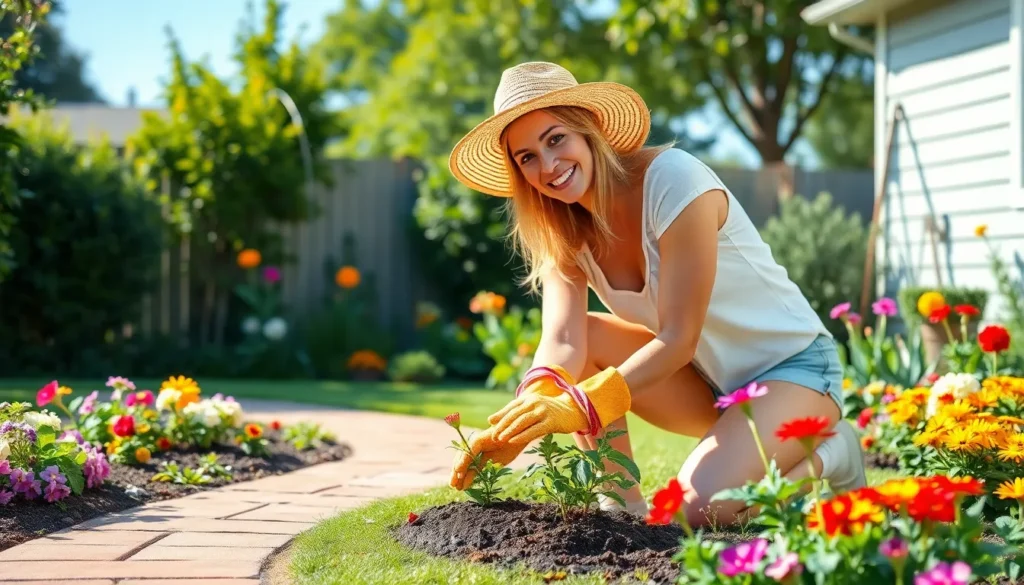Table of Contents
ToggleTransforming a garden isn’t just about planting flowers and pulling weeds; it’s a chance to unleash creativity and add a splash of personality to outdoor spaces. Whether it’s a cozy nook for morning coffee or a vibrant party zone, a garden makeover can turn a dull patch of earth into a stunning retreat. Who wouldn’t want to swap a patchy lawn for a lush paradise?
Importance Of A Garden Makeover
A garden makeover significantly improves the aesthetic appeal of outdoor spaces. Transforming a dull area into a vibrant retreat encourages relaxation and enjoyment. Such enhancements create an inviting atmosphere for family and friends to gather. Increased functionality is another vital aspect; well-planned gardens offer spaces for dining, entertaining, or simply unwinding.
Maintenance becomes more manageable with a thoughtful redesign. By selecting low-maintenance plants, individuals can reduce time spent on upkeep while maintaining beauty. Incorporating native plants supports local biodiversity and requires less water, fostering an environmentally friendly approach.
Personal expression plays a crucial role in garden makeovers. Unique design elements reflect individual styles and preferences, making a space truly one’s own. Creative use of colors, textures, and materials enhances visual interest, stimulating the senses and inspiring creativity.
Improvements in property value often accompany a garden makeover. A well-designed landscape adds curb appeal, attracting potential buyers and increasing market worth. Statistics indicate that landscaping improvements can yield a return on investment of up to 100% to 200%, making it a sound financial choice for homeowners.
Emotional well-being benefits from enhanced green spaces. Spending time in nature can reduce stress levels and promote mental clarity. A transformed garden serves as a sanctuary, allowing individuals to reconnect with nature and rejuvenate their spirits.
Ultimately, a garden makeover leads to a multitude of benefits that enhance both the quality of life and property investment.
Planning Your Garden Makeover

Planning a garden makeover requires thoughtful consideration. Budgeting and theme selection significantly influence the outcome of the project.
Setting a Budget
Establishing a budget is essential for any garden makeover. Identify the amount to allocate for plants, materials, and labor. Determine specific costs for various elements, such as soil, mulch, and hardscaping features. Research local suppliers for competitive pricing on plants, which can reduce overall expenses. Set aside funds for unexpected costs, ensuring flexibility in the budget. Aim for a well-defined financial plan that aligns with personal goals, making it easier to manage expenditures as the project progresses.
Choosing a Theme
Selecting a theme brings cohesion and style to the garden. Consider preferences, such as contemporary, rustic, or cottage designs. Incorporate elements like color palettes, plant types, and decorative features into the chosen theme. Assess the garden’s existing layout to enhance the theme further. Use native plants within the theme for sustainability and local biodiversity support. Explore inspiration from magazines, websites, or local gardens to visualize possible themes. Effective theme selection creates an inviting atmosphere that reflects personal taste and enhances enjoyment in outdoor spaces.
Key Elements To Consider
A successful garden makeover involves several key elements that ensure a stunning transformation. Focusing on plants, hardscaping, and lighting creates an inviting outdoor space.
Plants and Flowers
Select a variety of plants and flowers for visual interest. Incorporating native species fosters local biodiversity and reduces maintenance. Seasonal blooms provide color changes throughout the year. Consider perennials for lasting beauty, as they return year after year. Grouping plants by height and color enhances the overall design. Include fragrant options, like lavender or rosemary, to please the senses.
Hardscaping Features
Integrate hardscaping features for structure and functionality. Patios, walkways, and retaining walls establish defined areas within the garden. Use materials that complement the house and surroundings, such as stone, brick, or concrete. Incorporating seating areas encourages relaxation and enjoyment. Water features, like fountains or ponds, add soothing sounds and attract wildlife. Maintain a balance between hardscape and softscape for visual harmony.
Lighting Options
Incorporate lighting to extend usability into the evening hours. Pathway lights enhance safety and guide visitors through the garden. Consider string lights for a whimsical touch in seating areas. Landscape lighting showcases architectural features and highlights plant selections. Solar-powered options provide energy efficiency and ease of installation. Adjusting the lighting enhances mood, creating a welcome atmosphere.
DIY Vs. Hiring Professionals
Choosing between a DIY approach and hiring professionals for a garden makeover requires careful consideration. Many homeowners opt for DIY projects, appreciating the personal touch and the potential cost savings. Creating a garden space with hands-on work provides a sense of accomplishment. Gathering supplies, planning layouts, and selecting plants fosters creativity and ensures the final design reflects individual preferences.
On the other hand, hiring professionals brings expertise that can greatly enhance the project. Landscape designers understand plant placement and hardscaping best practices, ensuring optimal aesthetic appeal and functionality. Relying on professionals often leads to well-executed designs that incorporate innovative ideas and advanced techniques. Those seeking efficiency and high-quality results may prefer to invest in professional services.
Cost factors play a crucial role in this decision. DIY projects might appear more budget-friendly at first, yet hidden expenses can arise from mistakes or purchasing the wrong materials. Conversely, while hiring professionals requires a higher upfront cost, successful implementation can yield significant returns. Well-designed landscapes can increase property value, often between 100% to 200%, making the investment worthwhile.
Time and effort also influence this choice. DIY gardening demands substantial time commitment for planning, implementing, and maintaining the garden. Professionals can streamline the process, tackling complex tasks efficiently. Homeowners might find that their time is better spent enjoying leisure activities rather than engaging in extensive gardening work.
The decision hinges on personal preferences for creativity, level of expertise, financial considerations, and available time. Whether opting for DIY or hiring professionals, each approach offers unique advantages that can transform outdoor spaces.
Maintenance After The Makeover
Maintaining a garden after the makeover is essential for sustaining its beauty and functionality. Regular watering ensures plants thrive, particularly during dry spells. Fertilizing every six to eight weeks promotes healthy growth, especially for flowering plants and vegetables. Weeding minimizes competition for nutrients, so checking for invasive plants weekly supports overall health.
Mulching around plants retains moisture and suppresses weeds. Applying a layer of organic mulch can add nutrients as it breaks down over time. Pruning should occur regularly to remove dead or overgrown branches, enhancing plant shape and encouraging new growth. Monitoring for pests and diseases helps catch issues early, with methods like insecticidal soap providing effective treatment against common pests.
Seasonal evaluations are crucial for a thriving garden. Assessing how well plants adapted can inform future choices, and choosing native species often leads to lower maintenance needs. Designing the garden to minimize water requirements reduces overall upkeep and supports environmental sustainability. Shifting to low-maintenance plants like sedums or ornamental grasses can simplify daily tasks significantly.
Scheduling seasonal cleanups can keep the space tidy and enjoyable. Clearing debris and fallen leaves prevents pest habitats, while refreshing mulches and compost helps sustain soil health. Ensuring pathways remain clear and accessible also enhances usability during gatherings, encouraging more outdoor enjoyment.
Utilizing professional help can further improve maintenance efficiency. Garden services often provide regular upkeep, reducing stress for homeowners. Being proactive with maintenance tasks establishes a sustainable garden that continues to thrive and deliver enjoyment over time.
A garden makeover offers an opportunity to create a personal oasis that enhances both beauty and functionality. With thoughtful planning and design, outdoor spaces can transform into inviting retreats that reflect individual styles and promote relaxation.
By selecting the right plants and incorporating hardscaping and lighting, homeowners can achieve a stunning aesthetic that supports local biodiversity. Whether choosing a DIY approach or hiring professionals, each option presents unique advantages that can lead to a successful transformation.
Ongoing maintenance ensures that these beautiful spaces remain vibrant and enjoyable for years to come. Embracing the journey of a garden makeover can ultimately lead to a rewarding experience that enriches both lifestyle and property value.







